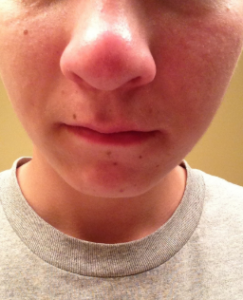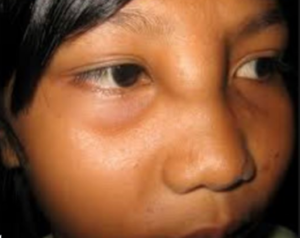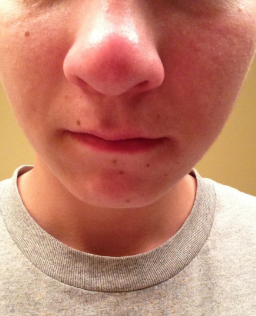Having a swollen nose bridge or glands is annoying. The swelling can be as a result of nose piercing or any other underlying cause. In this page, we uncover the possible causes, treatment options and home remedies to reduce the swelling on your nose.

Nose swelling is a type of problem that could first be evaluated by a primary care physician. The swelling could occur due to different sources. Your nose could swell for instance if you bumped the nose in some way or sustained trauma. The swelling can also result from a pimple or a bump that runs deep enough. The bump could progress into an abscess which makes the nose appear swollen, red and in most cases painful.
Allergic reaction from environmental allergens is the other common cause of nose swelling. This allergen includes such things as pollen grain or dust mites. You need to have a health care provider diagnose the problem. Treatment can then be prescribed depending on the history of the problem.
Causes of a swollen nose on tip, inside and outside
As mentioned above, a nose swelling can be quite painful and discomforting. The severity of the pain and other symptoms will depend on the underlying cause of the problem. For mild cases, the swelling might be only for some days then shrink off to normal. For severe cases, however, the swelling may worsen and even lead to serious complications like deforming of the face.
Below, we have provided some of the possible causes of the swelling. Some might be serious whereas others are mild and can clear with home care treatment. Understanding the underlying cause of the swelling is the first step in trying to resolve the swelling. Seek medical attention for diagnosis if you notice the swelling last for more than a day and does not seem to clear.
1. Swollen nose allergy
An allergy is immune system response due to the introduction of foreign objects or particles. Common symptoms associated with an allergy will include sneezing, itchy runny or blocked nose, watery eyes, red rash or swollen lips, tongue, eyes and face.
A substance capable of causing this kind of allergic reaction is called an allergen and can include pollen rain and dust. You need to see your doctor if the symptoms listed above last for more than a week.
2. Swollen nose pimple
A pimple causing the nose to swell can be inside the nose or on the nose. Folliculitis or the inflammation of the hair follicle is the common causes of this pimple. The swelling can be painful and will in most cases resolve on its own within a week without treatment.
3. Sinus infection
Also called rhinosinusitis, this infection is the inflammation of the soft tissues that line the sinuses. With this condition, symptoms will include pain around your face, nose blockage, congestion and fever among others.
4. Non-allergic rhinitis
Non-allergic rhinitis is known to cause chronic sneezing, congestion and runny nose. While the symptoms are the same to hay fever or allergic rhinitis, the only difference is that it does not involve the immune system.
5. Nose injuries and physical trauma
Nose injuries and trauma are common in everyday life. If the nose cartilage is not broken, then a simple cold compress can be used to relieve the pain and reduce the swelling. Over the counter, painkillers can also be used to offer relief for the pain.
Swollen nose piercing
Body piercing is a common cosmetic procedure done by many people nowadays. The piercing is done to in order to insert a ring, studs or other pieces of jewelry. Piercing may have only become widely popular in mainstream culture in recent in recent years, but the practice of body piercing is far from new.
The nose is the most prominent feature. It sets the character for the whole face (Leonardo Da Vinci). Most people believe a nose piercing can accentuate the face. This explains why nose piercing is a very attractive type of piercing on many people.
If you have just got your nose pierced, most piercing professionals insist that it is perfectly normal for it to be red, swollen, and tender or even bleed a little. This kind of symptoms is to be expected. If however, the said symptoms last for than a week, then they become a clear sign of infection.
If at this time you are worried that something was not done right, you need to check with the piercer (the person who performed the piercing) if everything was done right, then have a professional health care provider diagnose the condition to establish why that is so.
To protect from infection after a nose piercing, you need to closely monitor the healing process a pierced nose. Keep the wound clean and avoid removing the ring or stud until the wound heals completely. To spot an infected wound causing the swelling, the following symptoms will be shown;
- A foul smelling, Yellowish or greenish discharge from the site of piercing
- Persistent swelling, tenderness, and redness
- A more serious infection resulting from the piercing might be shown by cold chills, nausea feeling, and fever
To prevent the infection from spreading to other parts of the body, you need to have the condition diagnose and treatment for the underlying cause prescribed.
Swollen nose cartilage
Nose cartilage is a resilient and smooth elastic tissue. It is a structural component of the rib cage, the ear, the nose and the bronchial tube. When we say that the nose cartilage is swollen, it is the skin and soft tissue around the cartilage actually becomes swollen not the cartilage itself. The cartilage itself does not swell.
For a mild cause of the swelling, as healing matures, the swelling will subside and the tissue will shrink around the underlying framework composed of cartilage and bone. The process of healing will take close to 4 weeks and will depend on the underlying cause and how severe the swelling is.
Swollen painful nose inside
Same to the swelling outside nose, different causes May also lead to painful swelling inside of the nose. The pain may cause a lot of discomforts and to a certain extent, it may lead to difficulties in breathing. This can be very problematic especially for children. If you notice a swelling that lasts for more than a week, you need to have it checked by a professional health care provider.
Nasal polyps are one of the causes of swelling inside the nose. Nasal polyps are benign growths of the lining tissue of the nose. Polyps can be triggered by chronic or recurring sinus infections, asthma, hay fever or cystic fibrosis. When left untreated, they can grow large enough to block your nasal passages, this can result in chronic nasal congestion.
Painful inside nose swelling can also be as a result of a swollen pimple or bump inside the nose. Folliculitis is one of the common cause of this kind of a pimple. A pimple can be inside or on the nose. The bacterial imbalance is the other reason these bumps forms inside your nose.
Septic perforation is the other possible cause of painful inside nose swelling. A nasal septum perforation is a medical condition in which the nasal septum, the cartilaginous membrane dividing the nostril- develops a hole or fissure. Diagnosing the cause of the perforation can be very challenging. This is because various potential causes are possible.
A thorough medical history will be required to try and elucidate the actual cause of the perforation. Seek medical attention for early diagnosis and treatment.
The swelling can also be due to an allergic reaction. Allergic rhinitis or hay fever is the swelling of the inside nose. An allergy is an immune response to environmental allergen. The allergen can be anything that causes an allergic reaction.
Inflamed nose due to cold is also a possible cause of the painful swelling inside nose. If the swelling lasts for more than a week, then you need to visit a health care provider.
Swollen nose tip cellulitis
Cellulitis is a common and potential serious bacterial skin infection. In most cases, it will appear as a swollen, red area of the skin that feels tender and hot. The conditions not contagious and as such t cannot be spread from one person to the other. Though common on lower legs, the condition can occur anywhere on the body.
It might affect only the skin surface or at times, the underlying tissues of your skin or spread to the lymph nodes and bloodstream. A symptom of cellulitis may include:
- Pain and tenderness
- Inflammation of the affected part of the skin
- High temperature
- Fluid filled bumps
- A skin rash that appears and spread fast
Cellulitis occurs when a certain type of bacteria enters through a cut or crack in the skin. Common sites of infection will include cuts, insect bites or surgical incisions. Weakened immune system, diabetes, and history of cellulitis increase the risk factor of developing cellulitis on tip of nose.
To diagnose the condition, your doctor will look at symptoms such as swelling of the skin, redness, and warmth of the affected area and swollen glands. To treat the condition, your doctor will most probably prescribe a 10-21 day regimen of oral antibiotic. The length of the treatment will, however, depend on the severity of the symptoms.
If you have had the condition before, you are more likely to develop it again. The following are some of the possible ways you can prevent the condition.
- For dry skin prone to cracking, make sure you use skin moisturizers
- You need to manage any skin condition that could lead to cellulitis, this includes condition such as eczema, athlete’s foot, and others
- Keep all skin cuts, and bites clean to prevent bacterial infection
- Make sure you wash your hand when touching wounds or any skin condition
Swollen nose glands
Also known as nodes, lymph glands are located throughout the body. They swell, enlarge or become tender when fighting infection. For instance, if your nose swells due to bacterial or viral infection, then the glands which are a part of the immune system will swell or become enlarged when trying to protect your body from this infection.
Swollen glands are common and most will clear when the underlying cause of the swelling has been cleared or treated. A cold compress twice a day will help relieve the pain caused by the swelling. Seek immediate medical attention for swelling that last for more than a week. This will be a clear sign of a serious medical condition.
Swollen Nose Bridge
Nose Bridge is the bony part of the nose overlying the nasal bones. Painful swelling on this part of the bone will in most cases occur during play, sports, accidents and falls. For this kind of cases, home remedies may offer relief from the pain and other symptoms like swelling and irritation.

A swollen nose bridge will make the nose appear crooked even when not broken. Most health care and primary physician will prefer to check an injured nose as soon as the swelling goes down. You are advised against taking nonsteroidal anti-inflammatory drugs such as ibuprofen for the first 48 hours after noticing the swelling.
When using home remedies such as cold compress using an ice pack, you are advised against applying the ice for longer than 20 minutes. You are also advised against falling asleep when the ice is on your skin. You are to keep your head elevated even while you sleep. This way, you are able to reduce the swelling.
Swollen Nose Bridge causes
Sinusitis or the inflammation of the nasal sinus is one of the most common causes of nose bridge swelling. Frontal sinusitis can cause pain in the forehead. The pain will often worsen when lying on your back.
Ethmoid sinusitis, on the other hand, happens behind the bridge of nose. This type of inflammation can cause pain between the eyes, eyelid swelling, loss of smell and pain when one try to touch the sides of the nose.
Other causes of the swelling will include traumas and injuries occurring on the face. All these causes will make the nose to become red, swollen and very painful.
Swollen Nose bridge treatment
Treating a swollen nose bridge depends on the underlying cause of the swelling. If the cause of the swelling is trauma or injuries, then a quick cold compress applied directly on nose will help relieve the swelling. Ice compress will also help relieve other symptoms such as inflammation and pain caused by the swelling.
The compress should be done in interval and should last for at least 20 minutes each. For optimal treatment, you need to place your head in such a position that the head remains elevated. To prevent complication or damage, you need to act quickly. Let you doctor diagnose to establish if the nasal bridge is broken.
Over the counter, painkillers can also help. If you are allergic to any drugs, you have a hyperactive immune system, weakened the immune system or you are pregnant, you should your doctor prescribe the medication to avoid complications.
For severe breaks or those that go untreated for more than a week, surgery will need to try and fix them. For minor breakage, however, manually realigning the bones and cartilage may reverse the effect of the breakage.
If on the other hand, the cause of the swelling is sinusitis or common cold, then a warm compress will be required. Medicine plus explains that inhaling steam up to 4 times a day can help unblock the sinuses and reduce the swelling.
Finally, antihistamine and decongestant medications work well to shrink the nasal passage reduce the swelling and dry up mucous. Refrain from poking with your finger or stuffing it with objects. This is known to cause bleeding or infection. Instead of blowing your nose too hard, try blowing it gently.
Swollen nose during pregnancy
According to research, your body volumes tend to increase when pregnant. This is due to hormonal changes and fluctuation in preparation for the baby. It is very common for pregnant women to produce and retain more fluids when pregnant. This in some extent will contribute to the swelling of the nose.
Some people will also report of having larger swelling in the morning compared to the rest of the days. The good news is that the swelling is not permanent and will improve after the pregnancy.
Some women will also experience a swollen nose as an early sign of pregnancy. As mentioned, this is due to fluctuation in hormonal levels that causes the secretion of excess fluids. The swelling will thus be caused by edema which is the swelling caused by excess water retention. When you notice this swelling and you suspect it to be a sign of pregnancy, take a pregnancy test to confirm that.
Swollen nose treatment, remedy
Home remedies are very important in cases of nose injuries. For traumas injuries causing the swelling, different remedies exist that might help relieve the pain and swelling. One of this remedies is ice compress. This will help prevent and minimize swelling. WebMD advises against applying the ice pack for more than 20 minutes or sleeping with the ice on your skin.
They also insist on keeping your head elevated while you sleep to help relieve the swelling faster. If you a prone to smoking, then you should not, until the swelling is resolved. This is because smoking slows healing as it decreases blood supply and delays tissue repair.
Aloe Vera is also known to reduce inflammation. Applying a fresh gel of aloe Vera on around nose can also help offer relief for the swelling. If you are to use any prescription topical cream for the swelling, then aloe Vera gel should not be used at the same time.
A meal comprising of either garlic, turmeric or onion can also help improve recovery in cases or cellulitis or any other bacterial infection causing your nose o swell. All the three contains antibiotic properties. To boost your immune system, even more, you can use vitamin C boosters.
Drink extra fluid, such as hot tea in other conditions such as nasal passage swelling.
Sources and references:
- Swollen nose causes
- Swollen nasal passage
- Relieving swollen nose
- How to reduce swollen nose
- Treating a swollen nose


